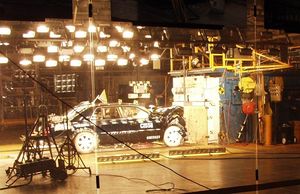.
Crumple zone
The crumple zone of an automobile is a structural feature designed to compress during an accident to absorb energy from an impact. Typically, crumple zones are located in the front part of the vehicle, in order to absorb the impact of a head-on collision, though they may be found on other parts of the vehicle as well. The crumple zone concept was pioneered by Mercedes-Benz and first introduced on the 1953 180 "Ponton" sedan.
Crumple zones work by lengthening the time a vehicle takes to come to a stop. This reduces the magnitude of the forces and deceleration felt by the occupants, since they are spread over a longer time. Therefore, a properly restrained passenger will have a smaller force applied to their bones and organs, and are more likely to survive a crash.
Their main disadvantage is that they dramatically increase the cost of post-collision repairs for low-speed accidents, where their benefit is already questionable (assuming the occupants are properly restrained). It is not unusual for older cars to be written off even with relatively minor damage due to repair costs exceeding the value of the car.


